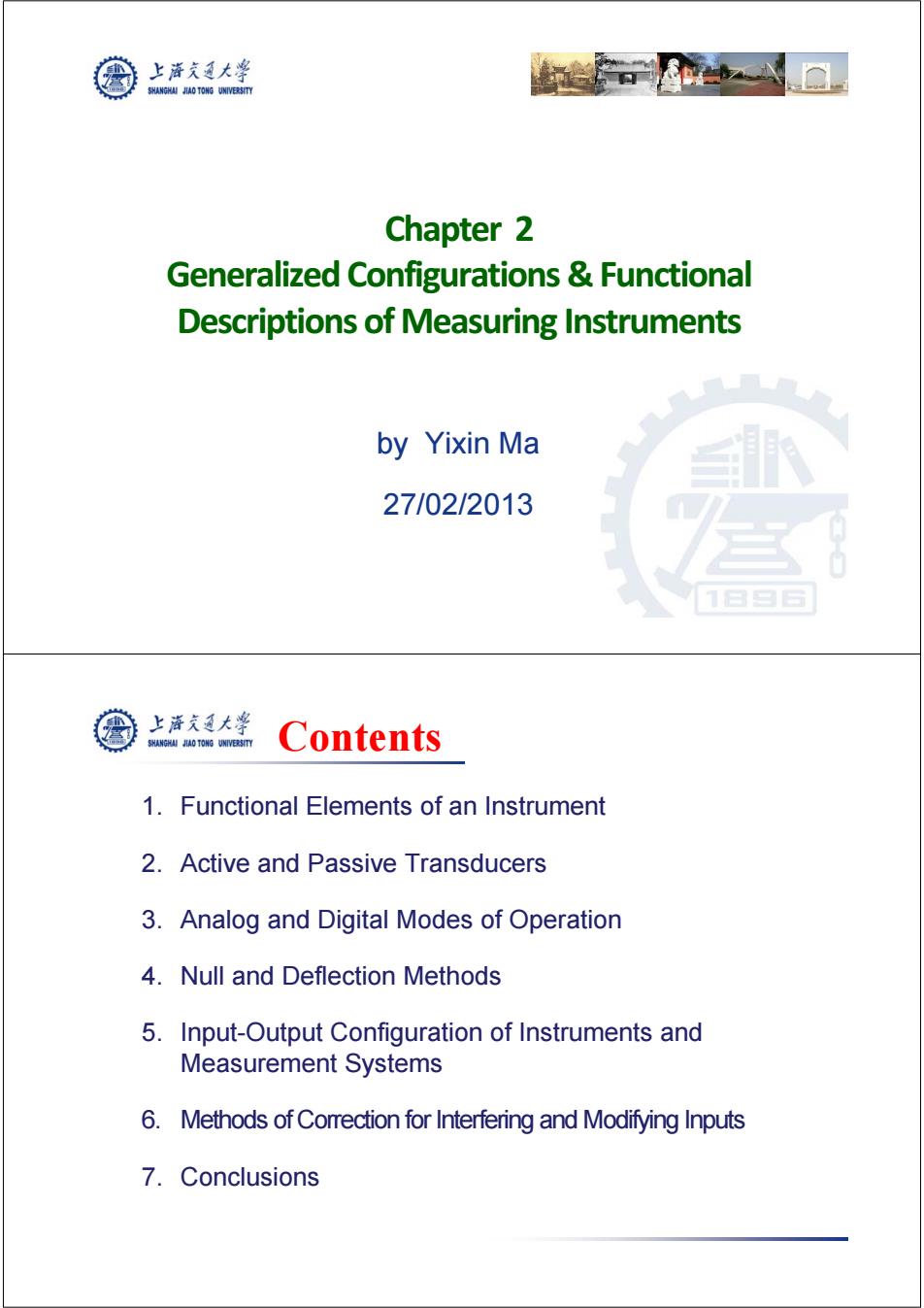
上游充通大¥ SHANGHAI JIAO TONG UNIVERSITY Chapter 2 Generalized Configurations Functional Descriptions of Measuring Instruments by Yixin Ma 27/02/2013 上浒充通大学 SHANGHAI JIAO TONG UNIVERSITY Contents 1.Functional Elements of an Instrument 2.Active and Passive Transducers 3.Analog and Digital Modes of Operation 4.Null and Deflection Methods 5.Input-Output Configuration of Instruments and Measurement Systems 6.Methods of Correction for Interfering and Modifying Inputs 7.Conclusions
Chapter 2 Generalized Configurations & Functional Descriptions of Measuring Instruments by Yixin Ma 27/02/2013 Contents 1. Functional Elements of an Instrument 2. Active and Passive Transducers 3. Analog and Digital Modes of Operation 4. Null and Deflection Methods 5. Input-Output Configuration of Instruments and Measurement Systems 6. Methods of Correction for Interfering and Modifying Inputs 7. Conclusions
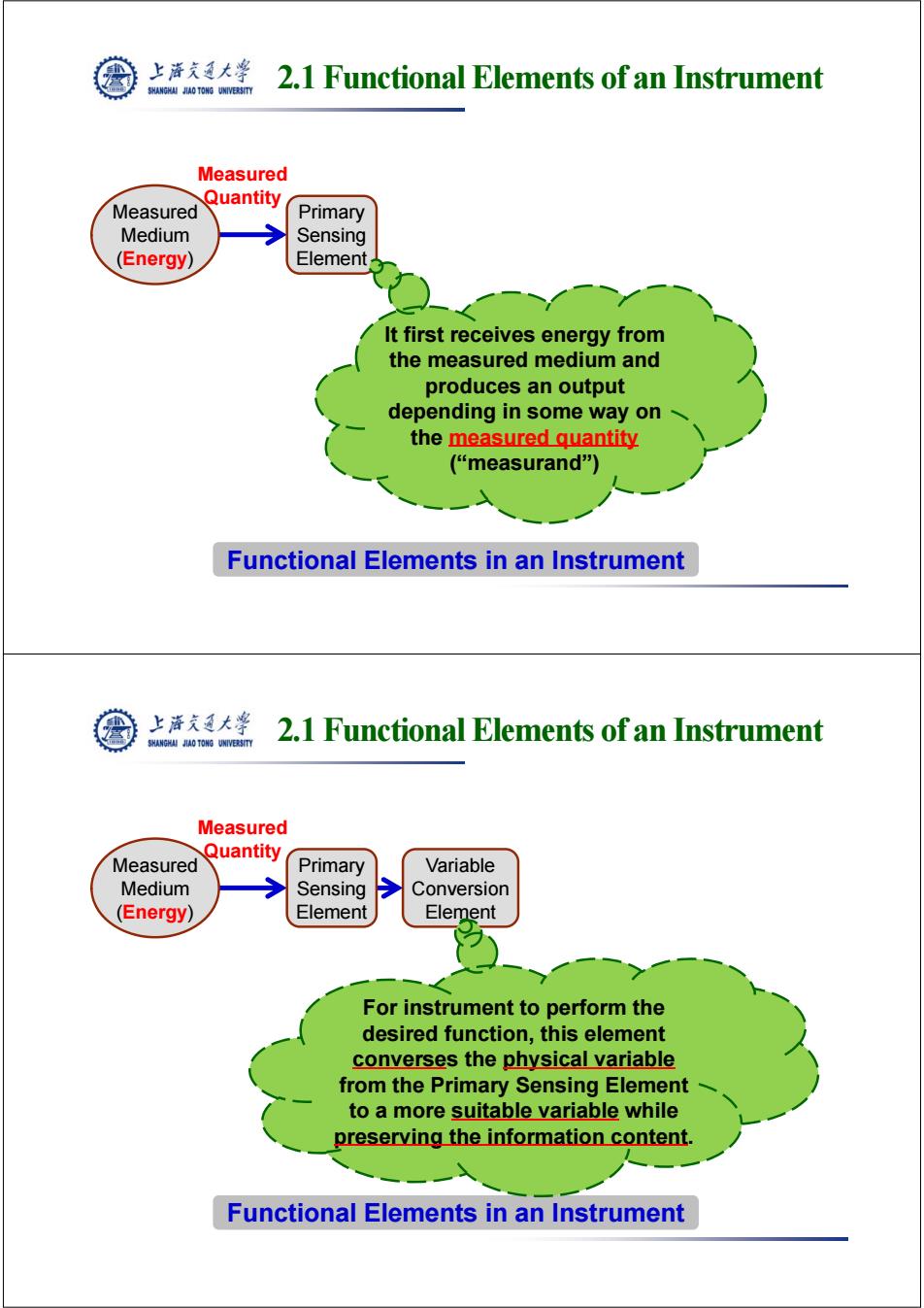
上海充通大学 SHANGHAI JIAO TONG UNIVERSITY 2.1 Functional Elements of an Instrument Measured Quantity Measured Primary Medium Sensing (Energy) Element It first receives energy from the measured medium and produces an output depending in some way on the measured quantity ("measurand") Functional Elements in an Instrument 上游文通大学 SHANGHAI JIAO TONG UNIVERSITY 2.1 Functional Elements of an Instrument Measured Quantity Measured Primary Variable Medium Sensing Conversion (Energy) Element Element For instrument to perform the desired function,this element converses the physical variable from the Primary Sensing Element to a more suitable variable while preserving the information content. Functional Elements in an Instrument
2.1 Functional Elements of an Instrument Measured Quantity Primary Sensing Element Measured Medium (Energy) Functional Elements in an Instrument It first receives energy from the measured medium and produces an output depending in some way on the measured quantity (“measurand”) 2.1 Functional Elements of an Instrument Variable Conversion Element Functional Elements in an Instrument Measured Quantity Primary Sensing Element Measured Medium (Energy) For instrument to perform the desired function, this element converses the physical variable from the Primary Sensing Element to a more suitable variable while preserving the information content
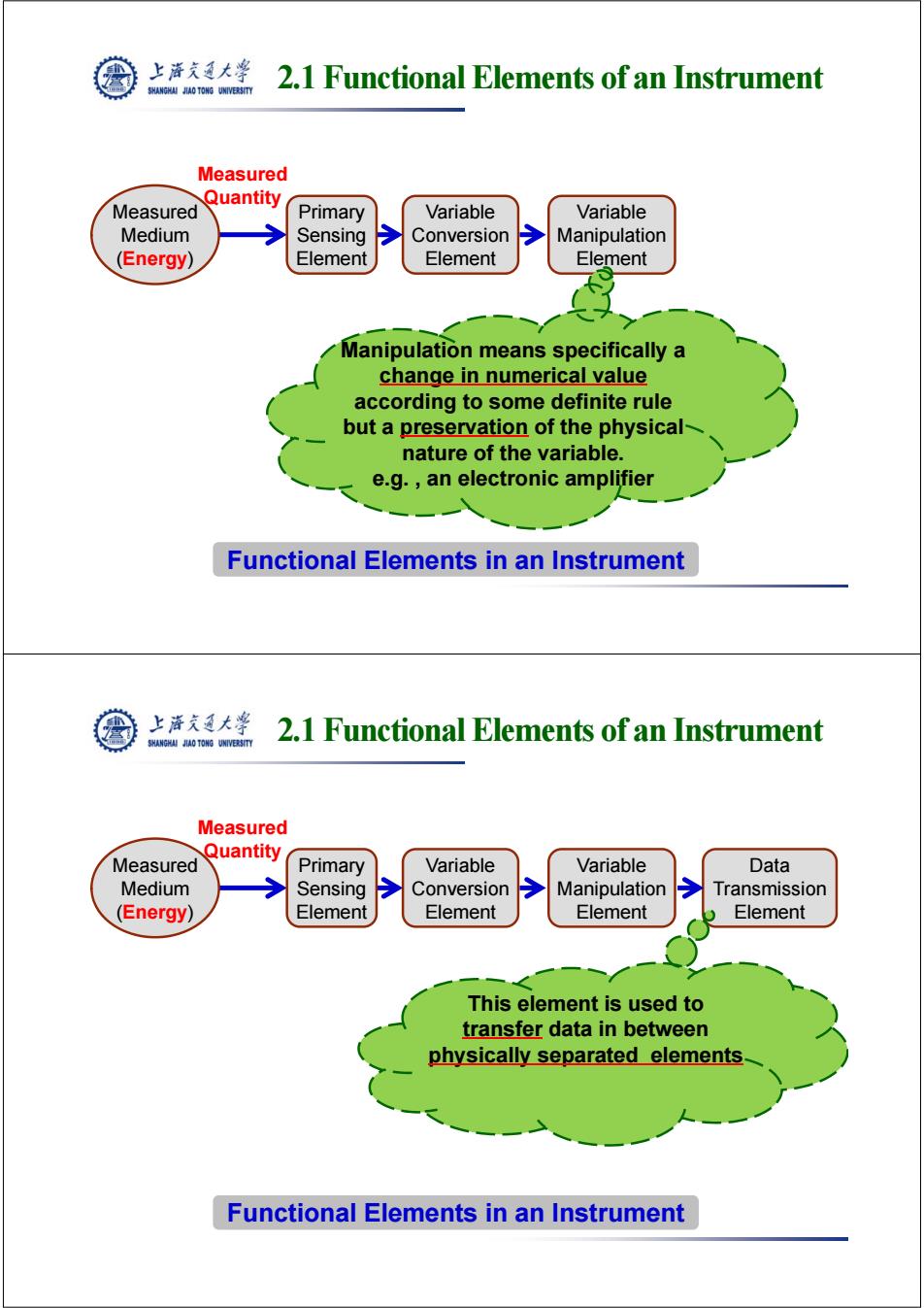
上游文通大学 SHANGHAI JIAO TONG UNIVERSITY 2.1 Functional Elements of an Instrument Measured Quantity Measured Primary Variable Variable Medium Sensing Conversion Manipulation (Energy) Element Element Element Manipulation means specifically a change in numerical value according to some definite rule but a preservation of the physical- nature of the variable. e.g.,an electronic amplifier Functional Elements in an Instrument 上游文通大学 SHANGHAI JIAO TONG UNIVERSITY 2.1 Functional Elements of an Instrument Measured Quantity Measured Primary Variable Variable Data Medium Sensing Conversion > Manipulation Transmission (Energy) Element Element Element Element This element is used to transfer data in between physically separated elements Functional Elements in an Instrument
2.1 Functional Elements of an Instrument Variable Conversion Element Variable Manipulation Element Functional Elements in an Instrument Measured Quantity Primary Sensing Element Measured Medium (Energy) Manipulation means specifically a change in numerical value according to some definite rule but a preservation of the physical nature of the variable. e.g. , an electronic amplifier 2.1 Functional Elements of an Instrument Variable Conversion Element Variable Manipulation Element Data Transmission Element Functional Elements in an Instrument Measured Quantity Primary Sensing Element Measured Medium (Energy) This element is used to transfer data in between physically separated elements
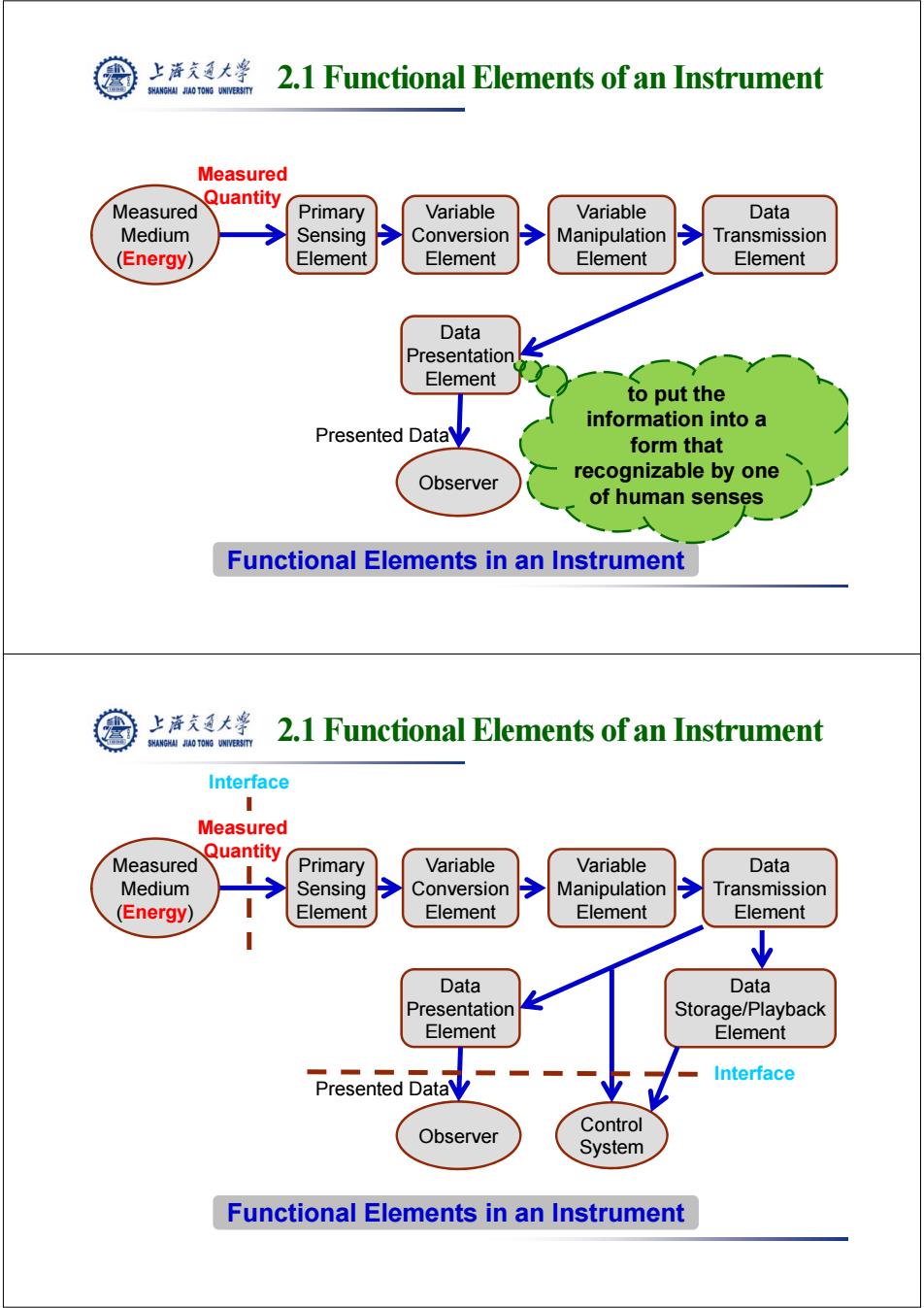
上游文通大学 SHANGHAI JIAO TONG UNIVERSITY 2.1 Functional Elements of an Instrument Measured Quantity Measured Primary Variable Variable Data Medium Sensing Conversion Manipulation Transmission (Energy) Element Element Element Element Data Presentation Element to put the information into a Presented Data form that Observer recognizable by one of human senses Functional Elements in an Instrument 上游文通大学 SHANGHAI JIAO TONG UNIVERSITY 2.1 Functional Elements of an Instrument Interface Measured Quantity Measured Primary Variable Variable Data Medium 1 Sensing Conversion Manipulation Transmission (Energy) Element Element Element Element 业 Data Data Presentation Storage/Playback Element Element Presented Data Interface Control Observer System Functional Elements in an Instrument
2.1 Functional Elements of an Instrument Variable Conversion Element Variable Manipulation Element Data Transmission Element Data Presentation Element Observer Presented Data Functional Elements in an Instrument Measured Quantity Primary Sensing Element Measured Medium (Energy) to put the information into a form that recognizable by one of human senses 2.1 Functional Elements of an Instrument Variable Conversion Element Variable Manipulation Element Data Transmission Element Data Storage/Playback Element Data Presentation Element Observer Control System Presented Data Interface Interface Functional Elements in an Instrument Measured Quantity Primary Sensing Element Measured Medium (Energy)
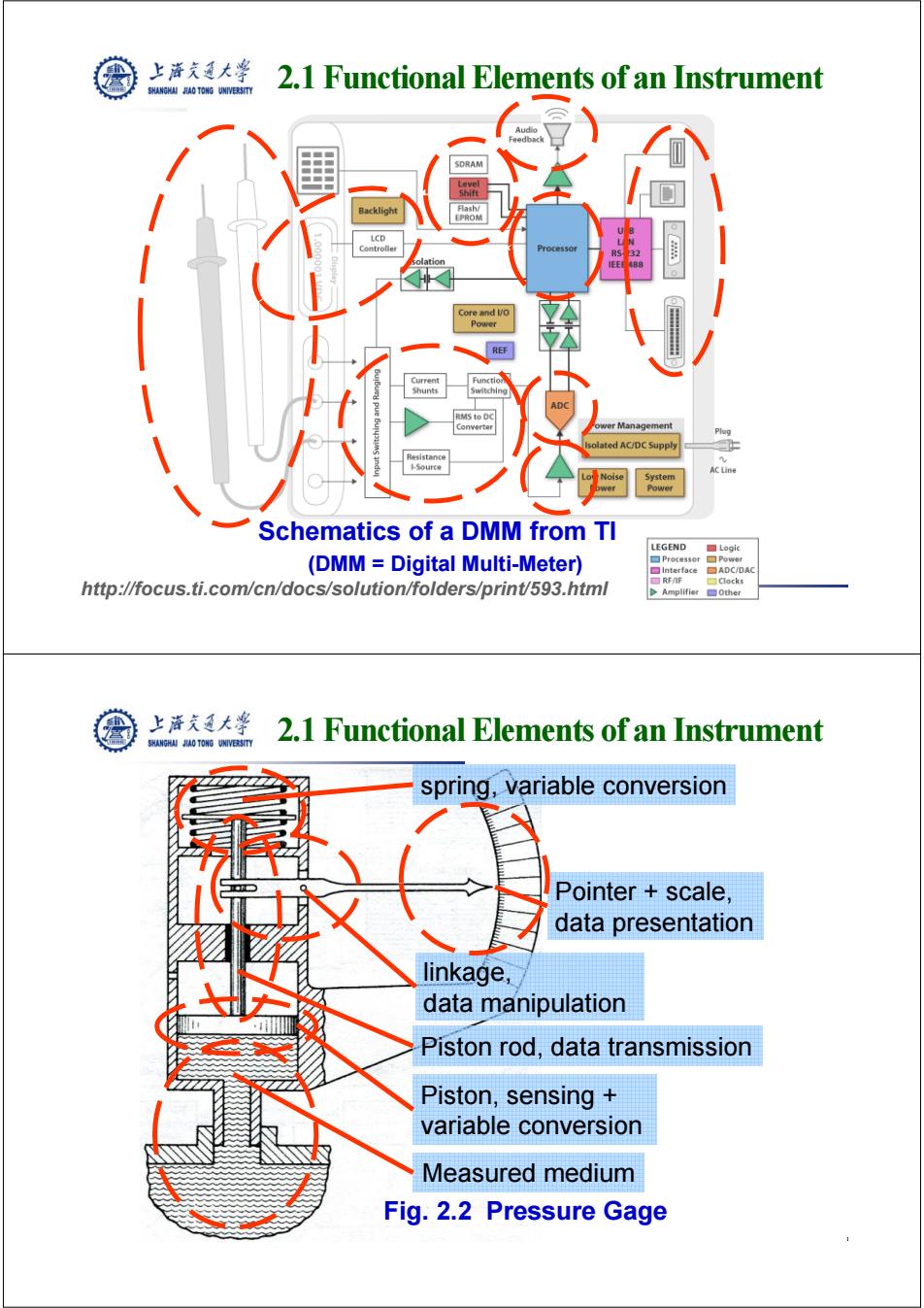
上海充通大学 2.1 Functional Elements of an Instrument SHANGHAI JIAO TONG UNIVERSITY DRAN Backlight LCD Core and lo Powe REF Current t Shunts MS to D onvert wer Management ted AC/DC Supply AC Line Schematics of a DMM from TI LEGEND ■Logi (DMM Digital Multi-Meter) http://focus.ti.com/cn/docs/solution/folders/print/593.html cks 上海充大学 SHANGHAI JIAO TONG UNIVERSITY 2.1 Functional Elements of an Instrument spring,variable conversion Pointer scale, data presentation linkage, data manipulation Piston rod,data transmission Piston,sensing variable conversion Measured medium Fig.2.2 Pressure Gage
2.1 Functional Elements of an Instrument Schematics of a DMM from TI (DMM = Digital Multi-Meter) http://focus.ti.com/cn/docs/solution/folders/print/593.html 2.1 Functional Elements of an Instrument Fig. 2.2 Pressure Gage Measured medium Piston, sensing + variable conversion Piston rod, data transmission spring, variable conversion linkage, data manipulation Pointer + scale, data presentation
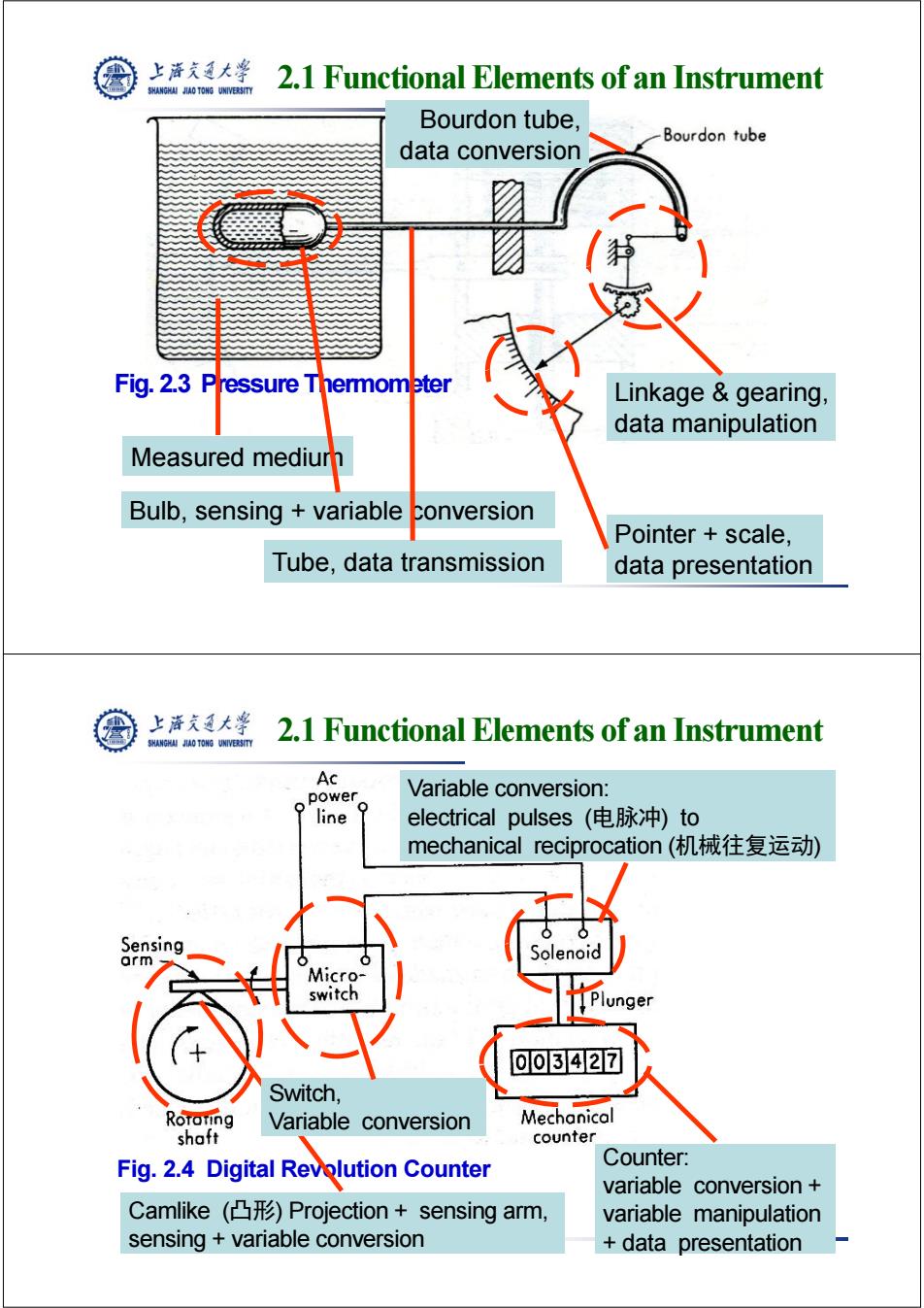
上游文通大学 2.1 Functional Elements of an Instrument SHANGHAI JIAO TONG UNIVERSITY Bourdon tube, Bourdon tube data conversion Fig.2.3 Pressure Thermometer Linkage gearing, data manipulation Measured mediur Bulb,sensing variable conversion Pointer scale, Tube,data transmission data presentation 上游充通大学 SHANGHAI JIAO TONG UNIVERSITY 2.1 Functional Elements of an Instrument Ac power Variable conversion: line electrical pulses(电脉冲)to mechanical reciprocation(机械往复运动) Sensing arm Solenoid Micro- switch 003427 Switch. Rororing Variable conversion Mechanical shaft counter Fig.2.4 Digital Revolution Counter Counter: variable conversion Camlike(凸形)Projection+sensing arm, variable manipulation sensing variable conversion data presentation
2.1 Functional Elements of an Instrument Fig. 2.3 Pressure Thermometer Measured medium Bulb, sensing + variable conversion Tube, data transmission Bourdon tube, data conversion Pointer + scale, data presentation Linkage & gearing, data manipulation 2.1 Functional Elements of an Instrument Fig. 2.4 Digital Revolution Counter Camlike (凸形) Projection + sensing arm, sensing + variable conversion Counter: variable conversion + variable manipulation + data presentation Variable conversion: electrical pulses (电脉冲) to mechanical reciprocation (机械往复运动) Switch, Variable conversion
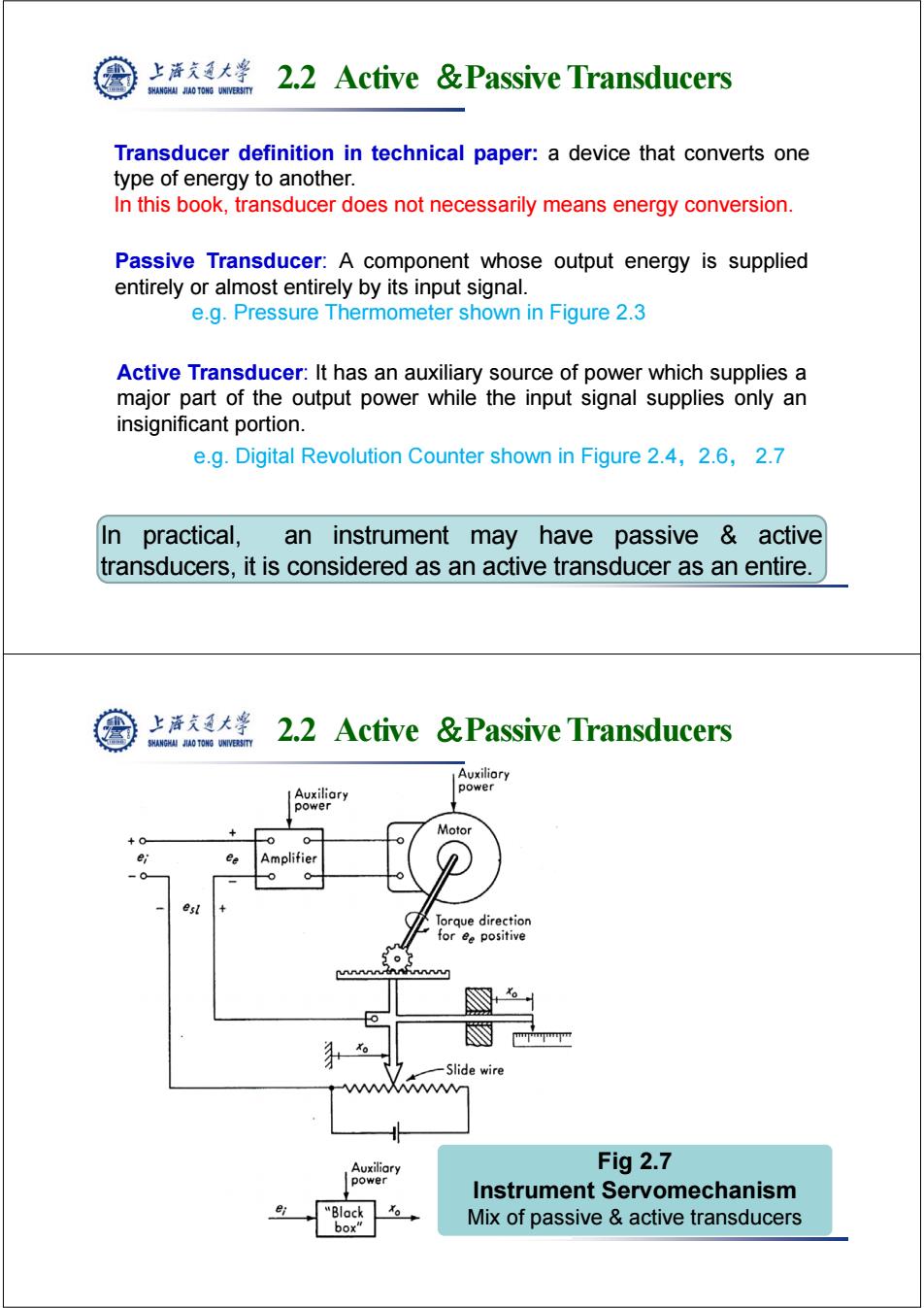
上海充通大学 2.2 Active &Passive Transducers SHANGHAI JIAO TONG UNIVERSITY Transducer definition in technical paper:a device that converts one type of energy to another. In this book,transducer does not necessarily means energy conversion. Passive Transducer:A component whose output energy is supplied entirely or almost entirely by its input signal. e.g.Pressure Thermometer shown in Figure 2.3 Active Transducer:It has an auxiliary source of power which supplies a major part of the output power while the input signal supplies only an insignificant portion. e.g.Digital Revolution Counter shown in Figure 2.4,2.6,2.7 n practical,an instrument may have passive active transducers,it is considered as an active transducer as an entire. 上泽充冠大学 SHANGHAI JIAO TONG UNIVERSITY 2.2 Active &Passive Transducers Auxiliory Auxiliary power power Motor +。 0 0 e Amplifier esl Torque direction for ee positive -Slide wire Auxiliary Fig 2.7 powe Instrument Servomechanism "Black box" Mix of passive active transducers
2.2 Active &Passive Transducers Transducer definition in technical paper: a device that converts one type of energy to another. In this book, transducer does not necessarily means energy conversion. Passive Transducer: A component whose output energy is supplied entirely or almost entirely by its input signal. e.g. Pressure Thermometer shown in Figure 2.3 Active Transducer: It has an auxiliary source of power which supplies a major part of the output power while the input signal supplies only an insignificant portion. e.g. Digital Revolution Counter shown in Figure 2.4,2.6, 2.7 In practical, an instrument may have passive & active transducers, it is considered as an active transducer as an entire. 2.2 Active &Passive Transducers Fig 2.7 Instrument Servomechanism Mix of passive & active transducers
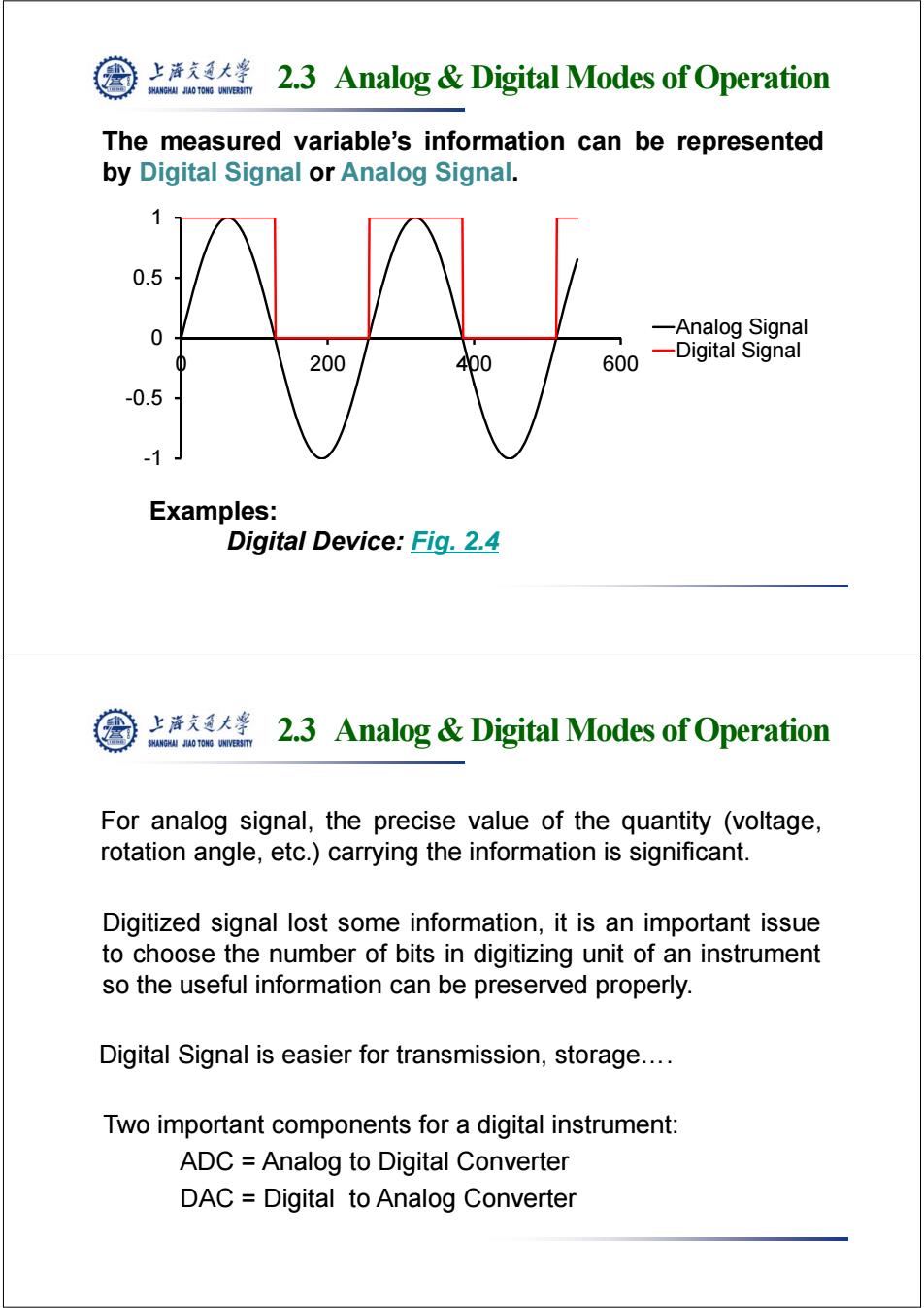
上海充通大学 SHANGHAI JIAO TONG UNIVERSITY 2.3 Analog Digital Modes of Operation The measured variable's information can be represented by Digital Signal or Analog Signal. 0.5 0 -Analog Signal 200 4p0 600 一Digital Signal -0.5 Examples: Digital Device:Fig.2.4 上海充通大学 SHANGHAI JIAO TONG UNIVERSITY 2.3 Analog Digital Modes of Operation For analog signal,the precise value of the quantity (voltage, rotation angle,etc.)carrying the information is significant. Digitized signal lost some information,it is an important issue to choose the number of bits in digitizing unit of an instrument so the useful information can be preserved properly. Digital Signal is easier for transmission,storage.... Two important components for a digital instrument: ADC Analog to Digital Converter DAC Digital to Analog Converter
2.3 Analog & Digital Modes of Operation The measured variable’s information can be represented by Digital Signal or Analog Signal. -1 -0.5 0 0.5 1 0 200 400 600 Analog Signal Digital Signal Examples: Digital Device: Fig. 2.4 2.3 Analog & Digital Modes of Operation For analog signal, the precise value of the quantity (voltage, rotation angle, etc.) carrying the information is significant. Digitized signal lost some information, it is an important issue to choose the number of bits in digitizing unit of an instrument so the useful information can be preserved properly. Digital Signal is easier for transmission, storage…. Two important components for a digital instrument: ADC = Analog to Digital Converter DAC = Digital to Analog Converter
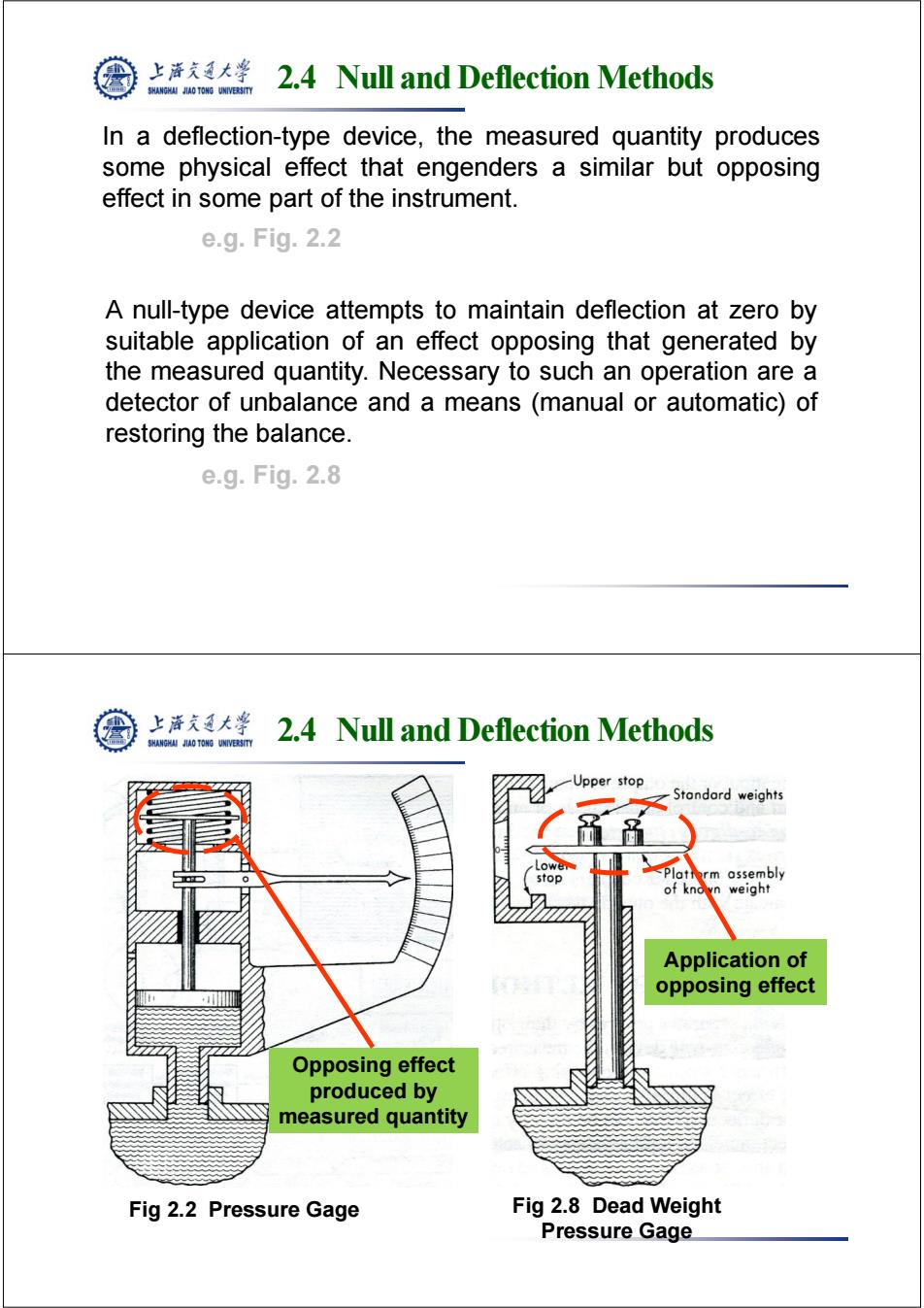
上海充通大学 2.4 Null and Deflection Methods SHANGHAI JIAO TONG UNIVERSITY In a deflection-type device,the measured quantity produces some physical effect that engenders a similar but opposing effect in some part of the instrument. e.g.Fig.2.2 A null-type device attempts to maintain deflection at zero by suitable application of an effect opposing that generated by the measured quantity.Necessary to such an operation are a detector of unbalance and a means (manual or automatic)of restoring the balance. e.g.Fig.2.8 上溶大学 2.4 Null and Deflection Methods SHANGHAI JIAO TONG UNIVERSITY Upper stop -Standord weights top Platt rm assembly of kno yn weight Application of opposing effect Opposing effect produced by measured quantity Fig 2.2 Pressure Gage Fig 2.8 Dead Weight Pressure Gage
2.4 Null and Deflection Methods In a deflection-type device, the measured quantity produces some physical effect that engenders a similar but opposing effect in some part of the instrument. A null-type device attempts to maintain deflection at zero by suitable application of an effect opposing that generated by the measured quantity. Necessary to such an operation are a detector of unbalance and a means (manual or automatic) of restoring the balance. e.g. Fig. 2.2 e.g. Fig. 2.8 2.4 Null and Deflection Methods Fig 2.2 Pressure Gage Opposing effect produced by measured quantity Application of opposing effect Fig 2.8 Dead Weight Pressure Gage
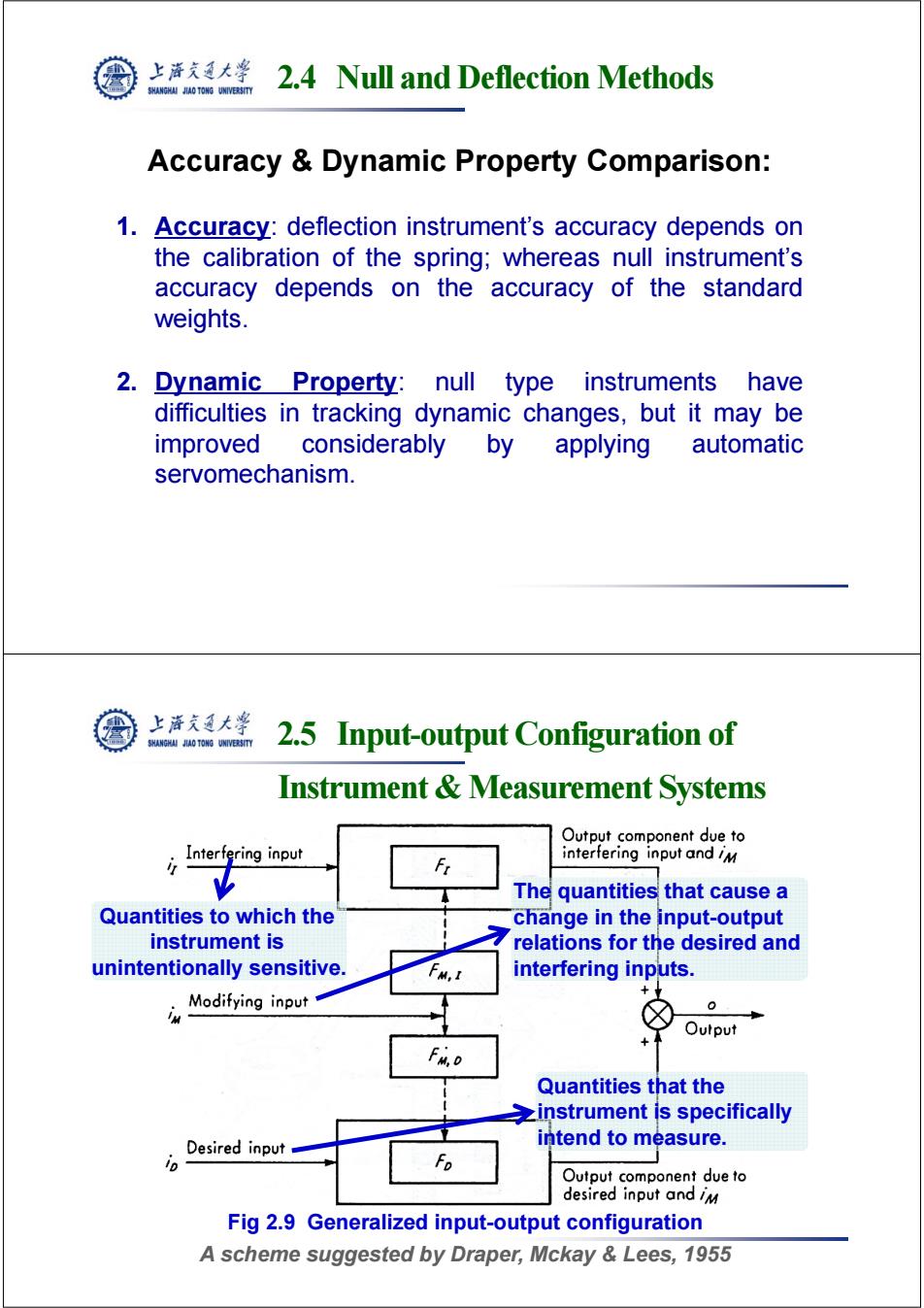
上游文通大学 2.4 Null and Deflection Methods SHANGHAI JIAO TONG UNIVERSITY Accuracy Dynamic Property Comparison: 1.Accuracy:deflection instrument's accuracy depends on the calibration of the spring;whereas null instrument's accuracy depends on the accuracy of the standard weights. 2.Dynamic Property:null type instruments have difficulties in tracking dynamic changes,but it may be improved considerably by applying automatic servomechanism. 上游充通大学 SHANGHAI JIAO TONG UNIVERSITY 2.5 Input-output Configuration of Instrument Measurement Systems Output component due to Interfering input interfering input and/ The quantities that cause a Quantities to which the change in the input-output instrument is relations for the desired and unintentionally sensitive. FM,I interfering inputs. Modifying input一 + 0 Output Quantities that the >instrument is specifically Desired input intend to measure. Output component due to desired input and im Fig 2.9 Generalized input-output configuration A scheme suggested by Draper,Mckay Lees,1955
2.4 Null and Deflection Methods Accuracy & Dynamic Property Comparison: 1. Accuracy: deflection instrument’s accuracy depends on the calibration of the spring; whereas null instrument’s accuracy depends on the accuracy of the standard weights. 2. Dynamic Property: null type instruments have difficulties in tracking dynamic changes, but it may be improved considerably by applying automatic servomechanism. 2.5 Input-output Configuration of Instrument & Measurement Systems Fig 2.9 Generalized input-output configuration A scheme suggested by Draper, Mckay & Lees, 1955 Quantities to which the instrument is unintentionally sensitive. Quantities that the instrument is specifically intend to measure. The quantities that cause a change in the input-output relations for the desired and interfering inputs